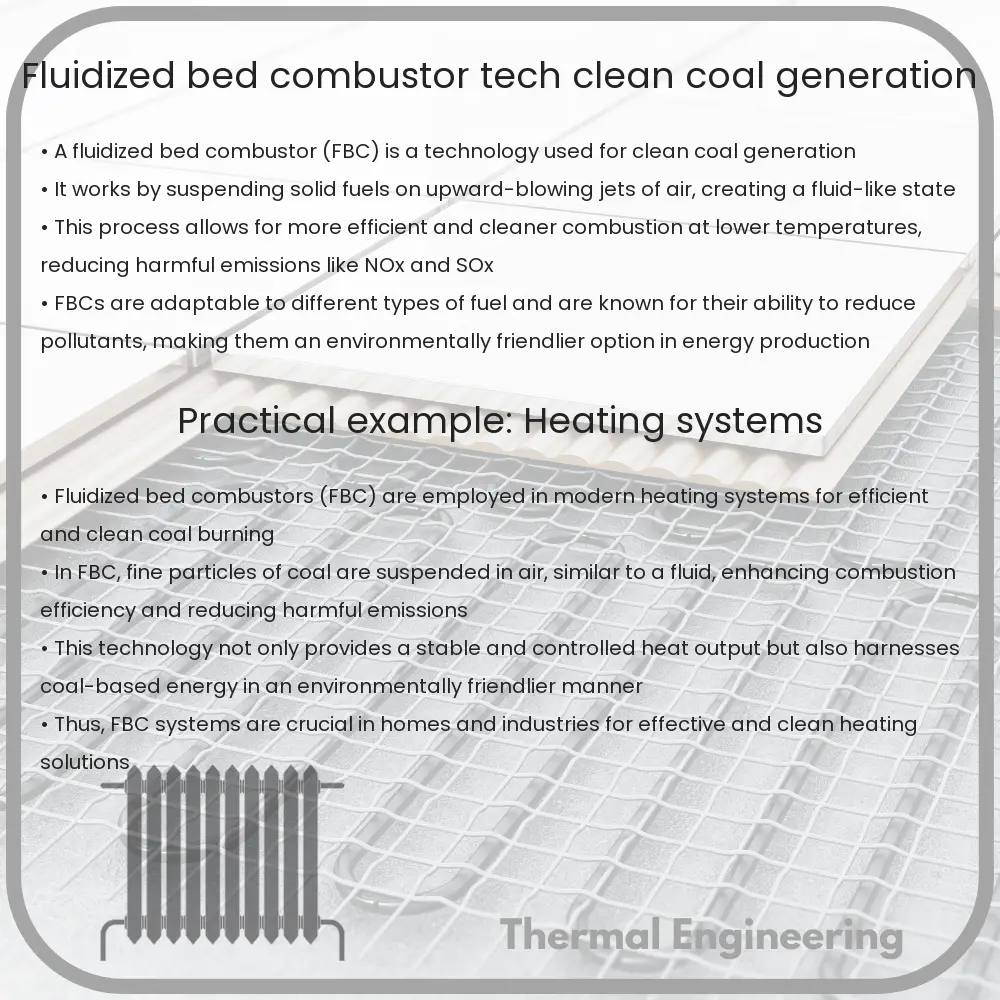Learn about fluidized bed combustors, a key technology in clean coal systems for enhanced energy efficiency and reduced emissions.

Understanding Fluidized Bed Combustors in Clean Coal Technology
Fluidized bed combustion (FBC) is a technology that can be used to achieve cleaner energy production from coal and other fuels. By allowing coal to burn more efficiently and cleanly, FBC systems play a crucial role in reducing pollution and enhancing energy efficiency in power generation.
What is a Fluidized Bed Combustor?
A fluidized bed combustor is a type of furnace or reactor in which fuels are burned in a bed of solid particles suspended in an upward-flowing stream of air or gas. The fluid flow causes the particles to be in a state of near-weightlessness, which is referred to as “fluidization. In this state, the bed of material has many properties of a fluid, hence the name.
Types of Fluidized Bed Combustors
- Bubbling Fluidized Bed (BFB) Combustors: In BFB, the gas velocity is moderate enough to keep the bed material relatively calm, yet intensely mixed. Larger particles remain in the bed while smaller particles and gases pass upward.
- Circulating Fluidized Bed (CFB) Combustors: CFB technology allows the bed to operate at higher velocities, which entrains the particles and allows them to circulate throughout the combustion chamber. This enhances the combustion efficiency and effectiveness of pollutant removal.
Advantages of Fluidized Bed Combustors
- Fuel Flexibility: FBC systems can handle a variety of solid fuels, including coal, biomass, or mixed fuels. This flexibility allows for balancing economic and environmental needs.
- Low Emissions: Due to the lower combustion temperatures (typically around 800°C to 900°C), the formation of NOx (nitrogen oxides) is significantly reduced compared to conventional coal-burning methods.
- Efficiency: The fluidized state ensures excellent heat transfer and uniform temperature distribution, leading to more efficient combustion and energy production.
- Ability to Capture SO2: Limestone can be added directly to the combustor, which reacts with sulfur dioxide (SO2) to form calcium sulfate salt, thus reducing SO2 emissions significantly.
The reduced emissions of particulates and harmful gases potentially make FBC an attractive technology for clean coal generation. However, handling and disposal of resultant solid wastes, such as ash containing inert materials and unreacted limestone, must be managed carefully to minimize environmental impact.
Challenges in Fluidized Bed Combustion
Despite the advantages, there are several challenges associated with FBC systems:
- Abrasion: The constant movement of particles within the combustor can lead to significant wear and tear on the system components.
- Agglomeration of Particles: At higher temperatures, some fuel particles might melt and stick together, disrupting fluidization and affecting performance.
- Control of Bed Temperature: Maintaining the optimal temperature for both combustion efficiency and pollution control can be complex.
Future of Fluidized Bed Combustors in Clean Coal Technology
With ongoing technological advances and increasing emphasis on reducing greenhouse gas emissions, the role of fluidized bed combustors in clean coal technology appears promising. Advances such as integrating FBC systems with carbon capture and storage (CCS) technologies could further reduce the environmental impact of coal-based power generation. As the world continues to seek balanced solutions between energy needs and environmental protection, FBC technology may offer one pathway toward achieving cleaner energy production.
The shift to cleaner technologies like fluidized bed combustion is essential for meeting current and future global energy demands while minimizing environmental degradation. The engineering and scientific communities continue to research and develop improvements in FBC design and operation to harness its full potential.